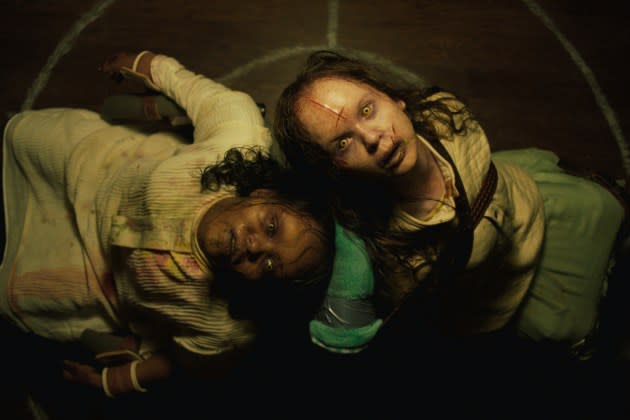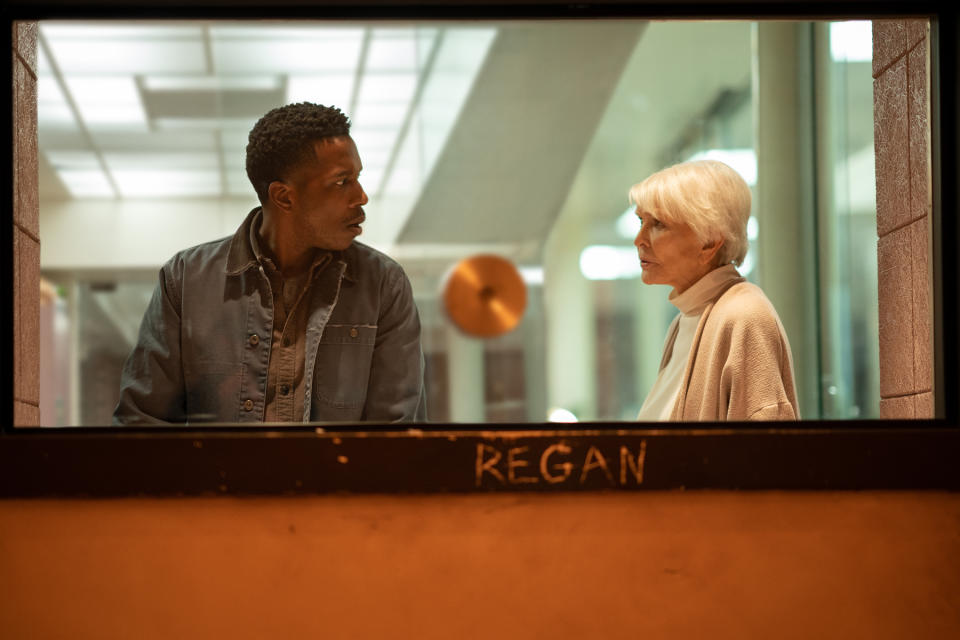‘The Exorcist: Believer’ Can Go Straight to Hell
- Oops!Something went wrong.Please try again later.
- Oops!Something went wrong.Please try again later.

A handful of the faithful and the pious might have been able to tell you what an exorcist was, or what they did, before the early 1970s. After William Friedkin’s blockbuster adaptation of William Peter Blatty’s bestselling horror novel hit screens in 1973, however, the term instantly became part of the cultural lexicon. Suddenly, everyone knew about priests who supposedly specialized in dealing with demonic possessions; there were reports that churches were getting dozens of calls from congregation members requesting (or claiming to need) the ancient ritual after the movie became a sensation. The word soon became synonymous with both resurgent Catholicism and certain types of horror flicks that dealt with the religious, the supernatural, and the satanic. But that original Exorcist didn’t just give birth to a wave of similar the-devil-made-me-do-it knockoffs. It also restarted a cultural conversation that resurrected a concept. Most nouns would kill for that kind of PR.
Real-life exorcists may want to hire a crisis-management firm, however, given the way The Exorcist: Believer drags said term through the mud. (At the very least, Pazuzu should consider suing for slander.) A “requel” — i.e., the thoroughly modern notion of a film that’s both a reboot and a sequel — designed to kick off a new trilogy, David Gordon Green’s attempt to breathe life into the series ends up immediately putting it on life support. Whether or not this unholy trinity ever gets past this disastrous inaugural outing, it’s safe to say that the brand, as well as your brain, ends up damaged. There are moments in this borderline incoherent mess of a movie in which fans may be convinced that its sole purpose is to try making the original follow-up, 1977’s legendarily godawful Exorcist II: The Heretic, look positively genius by comparison. You can’t blame the devil for this disaster. Even the Evil One would like his name removed from the credits, thank you very much.
More from Rolling Stone
'Totally Killer' Is a Time-Travel Slasher With a Brand New Final Girl
'The Caine Mutiny Court-Martial' Is the Perfect Ending to William Friedkin's Career
Big Suits, Lost Tapes, and Dancing Heads: Inside A24's Incredible 'Stop Making Sense' Restoration
Green has done requel duties before, having resuscitated the Halloween franchise with a threefer that started off incredibly strong, then became exponentially worse by its third time at bat. His Exorcist experiment, however, has the disadvantage of beginning on a low point. And like the original 1973 movie, Believer also opens with a bit of exotic misdirection: Instead of Iraq, we’re dropped in Port-au-Prince, Haiti, where photographer Victor Fielding (Leslie Odom Jr.) and his pregnant wife (Tracey Graves) are enjoying a vacation. She gets a blessing for the unborn baby from a local healer. Then the 2010 earthquake hits, and tragedy strikes. Whether this tie-in to an IRL catastrophe is supposed to lend gravitas to the eventual over-the-top tropes we’ve come to expect from something like this or not, there’s a slightly sulfuric odor to this preamble that whiffs of exploitation.
Some 13 years later, Victor and his now-teen daughter, Angela (Lidya Jewett), are living in Georgia. In an attempt to communicate with her dead mom, she and a school friend, Katherine (Olivia O’Neill), go into the woods to conduct a séance of sorts. Three days and one massive manhunt later, the duo are found in a stable several miles away, with no recollection of what’s happened or where they were. Victor and Katherine’s extremely Christian parents, Miranda (Jennifer Nettles) and Tony (Norbert Leo Butz), are worried that something horrible has happened to their kids — after all, she notes, kids going into woods basically means they’re communing with unholy spirits! Because what else would they be doing out there?!
The two teens return home. Strange things start happening. Angela has a tendency to turn bathroom lights off and on, and thinks she’s hearing voices. Also, there are some scars on her abdomen that maybe, just maybe, spell out “Help me.” (Sound familiar?) Katherine has developed a severe allergy to church, as well as polite behavior in public. Both of them begin to spend a lot of time in their respective beds and experience makeovers from Lucifer’s personal stylist. This is not normal sassy-teen behavior. Some heavy shit is going down. Victor’s holy-roller neighbor (Ann Dowd) thinks the local authorities, or even the neighborhood priest, can’t help them. They need to reach out to someone who’s dealt with this kind of thing before. Like that actress who lived in Washington, D.C., all those years ago, whose daughter experienced some similarly strange symptoms …

Part of any requel’s plan of attack involves pressing fans’ nostalgia buttons by bringing back old characters and the stars who played them, so it’s not surprising when Ellen Burstyn bursts back onto the scene as the O.G. concerned parent Chris MacNeil. She had turned her experience with the devil into a book — A Mother’s Explanation — which alienated her daughter, Regan; Mom has not seen or heard from her now-grown kid in ages. She agrees to help the families, which leads to a reunion of Chris and the malevolent force formerly known as Captain Howdy, now occupying not one body but two. Whatever giddy sensation bubbles up in die-hard Exorcist-heads from seeing the Oscar-winning actress gets quashed real quick, however, and by the time everyone has strapped Angela and Katherine into back-to-back chairs for some serious man-versus-demonically-possessed-teens throw downs, it’s all over but the head-spinning and “Tubular Bells” soundtrack cues.
Keen viewers can keep a tally over past Exorcist references that Green and his fellow writers (a lineup including Peter Sattler, Scott Teems, and Danny McBride) throw in, from repeated lines to replicating Dick Smith’s rotting-from-within makeup look; the fact that the film doesn’t even try to restage the iconic shot of Max von Sydow standing in silhouette is a small blessing in a movie brimming with curses. What’s more important than what’s being shouted out here in Believer, however, is what’s missing: a genuine sense of shock and awe. It isn’t just that the language and self-abusing gestures that threw 1973 audiences into fits have been tamped down and tamed (go back and watch the original, and you’ll be reminded of how obscene the demonic Regan’s dialogue still sounds), it’s also the way everything seems so familiar and yet so generic.
The climactic showdown might have been borrowed from any Blumhouse movie over the past 10 years. The Catholicism that was so key to the original film’s crisis of faith is pushed aside in favor of a ragtag multireligious crew that hammers home its message of belief in people being as important as belief in God. And even that inherently interesting notion is reduced to a wonky speech that poor Ann Dowd is forced to recite as one last montage wraps everything up. You simply won’t believe how The Exorcist: Believer somehow manages to get virtually nothing right about this whole endeavor — not the jump scares or sense of supernatural dread, not the subtext about the world falling apart and thus being primed for otherworldly evil, not the handling of Christian mythology, the concept of God or even the real object of its worship, the I.P. itself. If this is supposed to be the start of a new beginning for what’s been a longstanding, if also long-suffering franchise, then it may as well give up the ghost and go straight to hell.
Best of Rolling Stone

